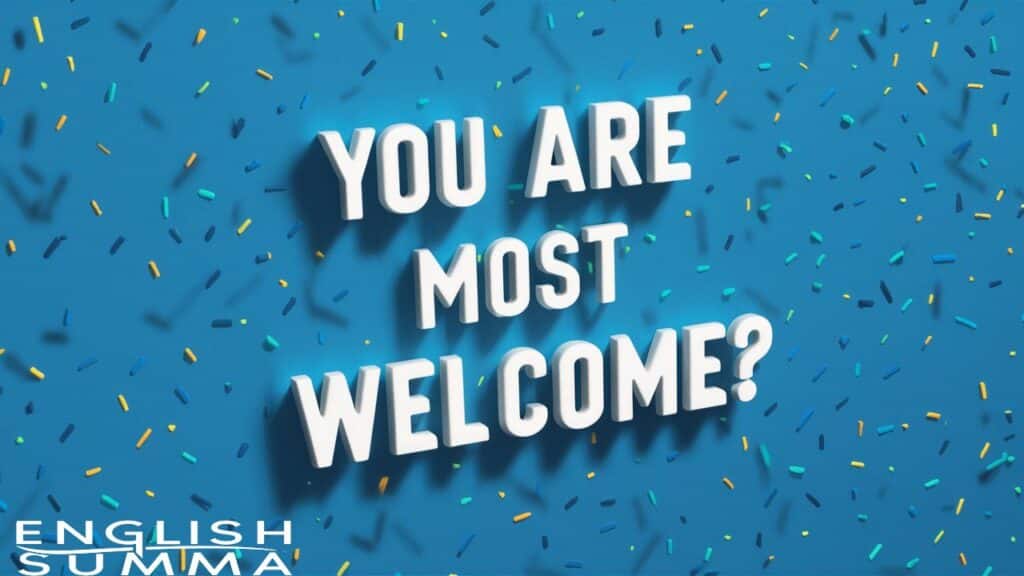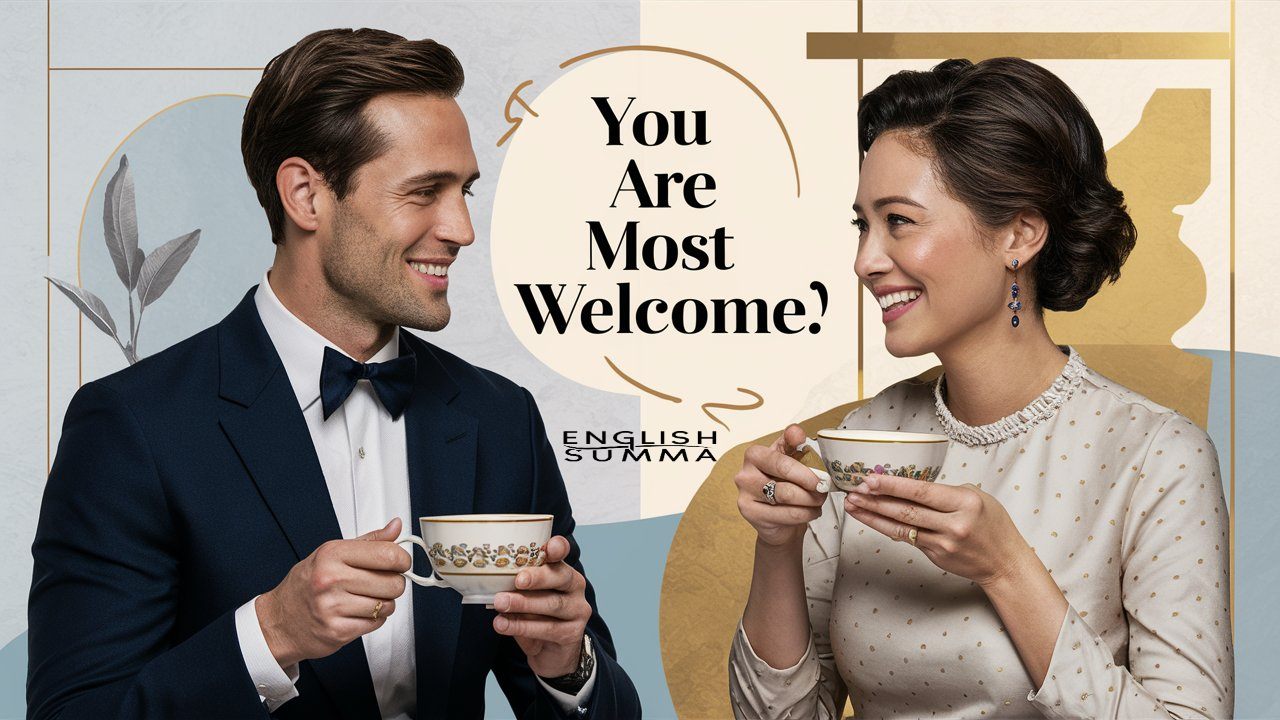Expressing gratitude and responding politely is an integral part of human communication. However, the nuances of these exchanges can vary greatly across cultures, contexts, and evolving language trends. One phrase that has sparked ongoing discussion is “you are most welcome” – a response to “thank you” that raises questions about its appropriateness and perceived level of formality.
Yes, it is correct and appropriate to say "you are most welcome" in highly formal settings and situations that require a heightened level of politeness and graciousness. This phrase conveys warmth, sincerity, and a strong affirmation that the act of kindness or service was genuinely appreciated. However, in casual, informal interactions with friends, family or coworkers, saying "you are most welcome" would be considered overly formal and pretentious. For casual contexts, simpler responses like "no problem," "anytime," or just "you're welcome" are more natural and suitable.
The Origins of “You’re Most Welcome”
The phrase “you’re most welcome” has its roots in the 18th century, emerging as a polite way to acknowledge gratitude. Historically, it was often used in formal settings and considered a more warm and gracious response compared to a simple “you’re welcome.” Its usage was heavily influenced by the cultural norms of the time, which placed a high emphasis on etiquette and proper manners.
> "You are most welcome, my dear friend, for any assistance I can render." - Jane Austen, Pride and PrejudiceAs language evolves, the phrase has taken on various meanings and connotations, reflecting the broader cultural shifts in how we communicate gratitude.
Unpacking the Phrase: What Does “Most” Signify?
At the heart of the debate lies the word “most” in the phrase “you are most welcome.” This word is intended to convey a heightened sense of warmth and sincerity, suggesting that the person expressing gratitude is not merely welcome but “most welcome.” It serves as a strong affirmation that the act of kindness or service was genuinely appreciated.
However, some argue that the addition of “most” can come across as overly formal or even exaggerated in certain contexts, particularly in casual conversations or situations where a simple “you’re welcome” would suffice.
| Setting/Context | Appropriate Response | Reasoning |
|---|---|---|
| Highly Formal (business, academic, etc.) | “You are most welcome” | Conveys warmth, sincerity, and a strong affirmation. Aligns with the heightened level of politeness expected in formal settings. |
| Casual Interactions with Friends/Family | “No problem”, “Anytime”, “You’re welcome” | Simpler, more natural responses are preferable in casual contexts. “You are most welcome” may come across as overly formal or pretentious. |
| Cross-Cultural Situations | Varies, research norms | Perceptions of appropriate gratitude responses can vary significantly across cultures. It’s important to understand and adapt to different cultural norms. |
| Digital/Online Communication | Emojis, GIFs, stickers, casual phrases | In the digital age, more casual and visually engaging expressions of gratitude (like emojis) have become common, especially in informal online interactions. |
| Tone and Body Language | Warm, engaged, sincere | Regardless of the specific words used, tone and body language play a crucial role in conveying genuine gratitude and a polite response. |
When Formality Meets Friendliness

The appropriateness of using “you are most welcome” largely depends on the context and the level of formality expected in a particular situation. In more formal settings, such as professional or academic environments, this phrase can be seen as a polite and respectful way to acknowledge gratitude.
For example, in a business meeting or a formal event, saying “you are most welcome” in response to a “thank you” from a colleague or client can convey a high degree of politeness and professionalism.
However, in casual interactions with friends or family, the phrase might come across as overly formal or even pretentious. In these less formal situations, a more relaxed tone and simpler expressions like “no problem,” “anytime,” or “you’re welcome” may be more suitable.
Cross-Cultural Perspectives on Graciousness
It’s important to note that the perception of what constitutes an appropriate response to gratitude can vary significantly across cultures. Some cultures place a greater emphasis on formality and elaborate expressions of gratitude, while others prioritize more casual and understated responses.
For instance, in many Asian cultures, responding to a “thank you” with a simple “you’re welcome” might be considered too abrupt or even rude. In these contexts, more extensive expressions of gratitude, such as “you are most welcome,” may be the norm.
On the other hand, in some Western cultures, particularly among younger generations, the use of “you are most welcome” could be perceived as overly formal or even outdated, reflecting broader cultural shifts towards more casual and direct communication styles.
The Casual Conversational Shift
As society evolves, there has been a noticeable trend towards more informal and casual interactions, even in professional settings. This shift is reflected in the way we communicate gratitude and respond to expressions of thanks.
In today’s fast-paced world, where communication often happens through digital channels and quick exchanges, the use of more concise and casual expressions like “no worries,” “sure thing,” or even emojis and GIFs has become increasingly common.
However, it’s essential to strike a balance between maintaining a friendly tone and preserving a level of politeness and respect. While casual responses can foster a sense of approachability and warmth, they may not be appropriate in all situations, particularly those that require a higher degree of formality.
Beyond Words: Body Language Matters
Effective communication goes beyond the words we use; our body language and tone play a crucial role in conveying the intended message and level of graciousness. When responding to expressions of gratitude, nonverbal cues such as eye contact, facial expressions, and gestures can significantly impact the overall perception of the response.
For example, saying “you are most welcome” with a warm smile and sincere eye contact can convey genuine appreciation and friendliness, even in more formal settings. Conversely, the same phrase delivered with a flat tone or a lack of engaged body language may come across as insincere or dismissive.
Innovations in Gratitude: Digital Age Impact
In the digital age, expressing gratitude and responding politely have taken on new forms. With the proliferation of online communication channels, such as instant messaging, social media, and video conferencing, modern alternatives to traditional expressions of gratitude have emerged.
For instance, the use of emojis, GIFs, and creative digital stickers has become a popular way to acknowledge thanks in a more informal and visually engaging manner. These digital expressions can add a layer of personality and warmth to virtual interactions, potentially bridging the gap between formal and casual communication styles.
However, it’s important to exercise caution when using digital expressions of gratitude, as they may not always be appropriate or well-received in professional or formal contexts.
Diversity in Alternatives to “You’re Most Welcome”

While “you are most welcome” remains a valid and polite response to expressions of gratitude, there is a wide range of alternative expressions that can be used depending on the context and the desired tone. Here are some common alternatives:
- “It was my pleasure”
- “I’m happy to help”
- “No problem at all”
- “Absolutely”
- “Don’t mention it”
- “I’m glad I could assist”
Each of these phrases conveys a different level of formality and warmth, allowing for greater flexibility in adapting to various situations and personal communication styles.
For example, “It was my pleasure” can be a gracious and sincere way to acknowledge gratitude while maintaining a polite and formal tone. On the other hand, “No problem at all” or “Don’t mention it” can be appropriate in more casual settings where a relaxed and friendly approach is preferred.
Putting It All Together
Ultimately, the decision to use “you are most welcome” or any other expression of gratitude should be guided by a combination of factors, including the context, the level of formality required, cultural considerations, and personal communication preferences.
Here are some general guidelines to help navigate this decision:
Formal Settings:
- In professional, academic, or highly formal contexts, “you are most welcome” can be an appropriate and polite response to expressions of gratitude.
- Consider the level of formality expected in the specific situation and the cultural background of the individuals involved.
Casual Interactions:
- In casual settings with friends, family, or less formal professional environments, more relaxed expressions like “no problem,” “anytime,” or “you’re welcome” may be more suitable.
- Avoid using “you are most welcome” in casual contexts where it might come across as overly formal or pretentious.
Cross-Cultural Awareness:
- Be mindful of cultural norms and expectations when communicating gratitude and responding to thanks.
- Research and adapt to the cultural background of the individuals involved to ensure appropriate and respectful communication.
Tone and Body Language:
- Regardless of the specific phrase used, pay attention to your tone and body language to convey sincerity and warmth.
- A friendly tone, eye contact, and engaged body language can enhance the perceived genuineness of your response.
Personal Preferences:
- Ultimately, choose an expression that aligns with your personal communication style and feels natural to you.
- Experiment with different phrases and observe how they are perceived by others to find the right balance of formality and friendliness.
Remember, the goal is to communicate gratitude in a way that is respectful, sincere, and appropriate for the given situation, while also reflecting your personal style and the evolving norms of modern communication.
Conclusion
In conclusion, the debate surrounding the appropriateness of saying “you are most welcome” highlights the nuances and complexities of expressing gratitude and responding politely. By considering factors such as context, formality, cultural norms, and personal preferences, we can navigate these interactions with greater awareness and effectiveness, fostering positive and meaningful connections with others.

